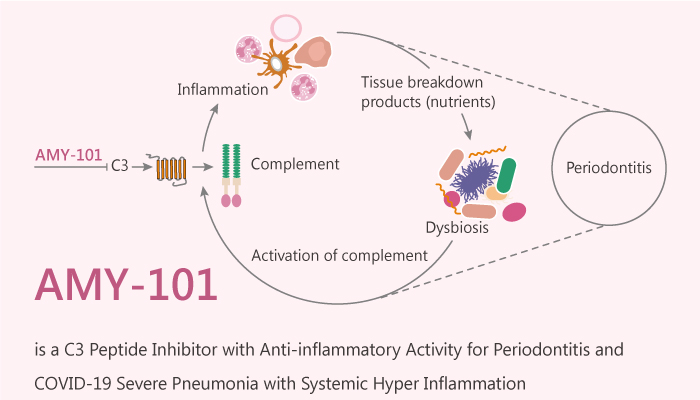The complement system helps or “complements” the ability of antibodies and phagocytic cells to clear pathogens from an organism. Specifically, the complement system is a complex network, including the interaction of the liquid phase, molecules related to the cell surface to trigger, and regulate the signal pathway involved. However, maladjustment or overactivation of complement can lead to many inflammatory diseases. Periodontitis is a chronic inflammatory disease related to the over activation of the complement system. Besides, host regulation therapy may be helpful for the effective treatment of human periodontitis. Moreover, acute respiratory distress syndrome (ARDS) is a devastating clinical manifestation of COVID-19 pneumonia, which is mainly based on immune driven pathology. Furthermore, C3 targeted interventions can provide more extensive treatment control for complement-mediated inflammatory injury in patients with COVID-19. AMY-101, a peptidic inhibitor of the central complement component C3, inhibits naturally occurring periodontitis in non-human primates (NHPs).

How does AMY-101 work for anti-inflammatory activity? Let’s study it together. In the beginning, AMY-101 (Cp40) is a peptidic inhibitor of the central complement component C3 and inhibits naturally occurring periodontitis in NHPs. In addition, AMY-101 exhibits subnanomolar affinity for C3 (KD=0.5 nM) and a plasma half-life that exceeds expectations for most peptidic drugs. Meanwhile, AMY-101 can improve the periodontal condition of NHPs with natural chronic periodontitis and induce a long-lasting anti-inflammatory effect. Nonetheless, AMY-101 causes a significant and long-lasting reduction in PPD, an index that measures tissue destruction. AMY-101 exhibits a favorable anti-inflammatory activity in models with COVID-19 severe pneumonia with systemic hyper inflammation. All in all, AMY-101, a peptidic inhibitor of the central complement component C3, inhibits naturally occurring periodontitis in NHPs.
References:
Kajikawa T, et al. Mol Ther Methods Clin Dev. 2017 Aug 18;6:207-215.